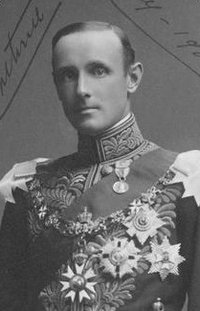John Hope, 1st Marquess of Linlithgow
|
|
John Adrian Louis Hope, 1st Marquess of Linlithgow (25 September 1860 - 29 February 1908), first Governor-General of Australia, was born at Queensferry, Linlithgowshire, Scotland, on 25 September 1860, the eldest son of the sixth Earl of Hopetoun. He was educated at Eton College and the Royal Military Academy Sandhurst, but did not join the army on graduation. Instead he managed the family estates and pursued a life of leisure. He served as a Lord in Waiting from June 1885 to January 1886 and August 1886 to August 1889. During his time in Australia he was known as Lord Hopetoun.
In 1889 he was appointed Governor of Victoria, where he served until 1895. His popularity in Victoria and his friendship with leading Australian politicians made him a logical choice to be the first Governor-General, and he was appointed in July 1900, arriving in Sydney in December, shortly before the inauguration of the Commonwealth of Australia on 1 January 1901.
Hopetoun's first task was to appoint a Prime Minister. Since no federal elections had yet been held, he could not follow the usual convention of appointing the leader of the majority party in the House of Representatives. So he offered the post to Sir William Lyne, the Premier of the largest state, New South Wales.
This decision was defensible in terms of protocol, but it ignored the fact that Lyne had opposed federation and was unpopular with the leading federalist politicians. Alfred Deakin and other prominent politicians told Hopetoun they would not serve under Lyne. Eventually Lyne returned his commission and Hopetoun sent for Edmund Barton, the leader of the federal movement and the man everybody believed was entitled to the post. Hopetoun was widely criticised for this "blunder".
Ac.linlithgow.jpg
Further problems soon arose. Hopetoun had brought his own official secretary, William Wallington, who handled all his communications with London. The Australians resented an Englishman being in charge of official business. They also resented the regal pomp with which Hopetoun insisted in carrying out his role, and the expense which this entailed. He also had an unfortunate tendency to speak as though he was co-ruler of Australia beside the Prime Minister, which was not the situation the Constitution envisaged.
Finally a dispute arose over the allowance to be paid to the Governor-General to enable him to maintain vice-regal residences in both Sydney, the largest city, and Melbourne, the temporary capital. Rivalries between New South Wales and Victoria led to both the Commonwealth and Victorian parliaments rejecting bills to pay Hopetoun an additional allowance. As a result Hopetoun abruptly resigned in May 1902.
An interesting friendship developed between Lord Hopetoun and the Melbourne anarchist and union pioneer, John 'Chummy' Fleming. In May 1901 Fleming protested unemployment in Melbourne by rushing onto the Prince's Bridge to halt the Governor General's carriage. Hopetoun told the police not to interfere and listened to Fleming put the case for the unemployed. Out of this encounter came a friendship which endured after Hopetoun returned to England. According to some reports, Hopetoun is credited with pressuring the government to speed up government work projects.
Hopetoun left Australia in July, acutely aware that he had failed in a historic role. In compensation he was created Marquess of Linlithgow, but failed to be appointed to the position he most wanted, Viceroy of India. He was Secretary for Scotland in 1905, and died suddenly on 29 February 1908. He is little remembered in Australia, although there is a fine equestrian statue of him on Linlithgow Avenue in Melbourne.
| Preceded by: Sir Henry Loch | Governor of Victoria 1889–1895 | Succeeded by: The Lord Brassey |
| Preceded by: Charles Seale Hayne | Paymaster-General 1895–1899 | Succeeded by: The Duke of Marlborough |
| Preceded by: The Earl of Lathom | Lord Chamberlain 1898–1900 | Succeeded by: The Earl of Clarendon |
| Preceded by: — | Governor-General of Australia 1901–1903 | Succeeded by: The Lord Tennyson |
| Preceded by: Alexander Murray | Secretary for Scotland 1905 | Succeeded by: John Sinclair
|

